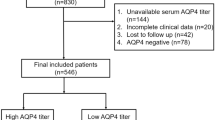Abstract
The aim of this study was to evaluate longitudinally functional and neuro-radiologic findings in childhood optic gliomas (OG), by comparing flicker visual evoked potentials (F-VEPs) with brain magnetic resonance imaging (MRI) changes. Fourteen children (age range: 1–13 years) with OGs underwent serial F-VEP, MRI and neuro-ophthalmic examinations over a 38 month (median, range: 6–76) follow-up. F-VEPs were elicited by 8 Hz sine-wave flicker stimuli presented in a mini-Ganzfeld. Contrast-enhanced MRI examinations were performed. Results of both tests were blindly assessed by independent evaluators. F-VEPs were judged to be improved, stable or worsened if changes in the amplitude and/or phase angle of the response exceeded the limits of test–retest variability (±90th percentile) established for the same patients. MRI results were judged to show regression, stabilization or progression of OG based on its changes in size (±20%) or extension. Two to seven pairs of F-VEP/MRI examinations per patient (median: 4) were collected. Based on a total of 38 pairs of F-VEP/MRI examinations, both tests agreeed in showing worsening (progression), stabilization and improvement (regression) in 5, 15 and 10 cases, respectively. In 3 cases, F-VEPs showed a worsening and MRI a stabilization, while in 5 cases F-VEPs showed an improvement and MRI a stabilization. Agreement between F-VEP and MRI changes was 78.9% (95% CI: ± 37%, K statistics = 0.67, P < 0.001). The results indicate that longitudinal F-VEP changes can predict changes in MRI-assessed OG size and extension, providing a non-invasive functional assay, complementary to neuro-imaging, for OG follow-up.



Similar content being viewed by others
References
North K, Cochineas C, Tang E, Fagan E (1994) Optic gliomas in neurofibromatosis type 1: role of visual evoked potentials. Pediatr Neurol 10(2):117–123
Listernick R, Louis DN, Packer RJ, Gutmann DH (1997) Optic pathway gliomas in children with neurofibromatosis 1: consensus statement from the NF1 Optic Pathway Gioma Task Force. Ann Neurol 41(2):143–129
Listernick R, Charrow J, Greenwald MJ, Mets M (1994) Natural history of optic pathway tumours in children with neurofibromatosis type I: a longitudinal study. J Paediatr 125:6366
Wright JE, McNabb AA, Mcdonald WI (1989) Optic nerve glioma and the management of optic nerve tumours in the young. Br J Ophthalmol 73:967–974
Lewis RA, Gerson LP, Axelson KA, Riccardi VM, Whitford RP (1984) von Recklinghausen neurofibromatosis II. Incidence of optic gliomata. Ophthalmology 91(8):929–935
Groswasser Z, Kriss A, Halliday AM, McDonald WI (1985) Pattern- and flash-evoked potentials in the assessment and management of optic nerve gliomas. J Neurol Neurosurg Psychiatry 48(11):1125–1134
Jabbari B, Maitland CG, Morris LM, Morales J, Gunderson CH (1985) The value of visual evoked potential as a screening test in neurofibromatosis. Arch-Neurol 42(11):1072–1074
Imes RK, Hoyt WF (1986) Childhood chiasmal gliomas: update on the fate of patients in the 1969 San Francisco Study. Br J Ophthalmol 70(3):179–182
Listernick R, Charrow J, Greenwald MJ, Esterly NB (1989) Optic gliomas in children with neurofibromatosis type 1. J Pediatr 114(5):788–792
Listernick R, Charrow J (1990) Neurofibromatosis type 1 in childhood. J Pediatr 116(6):845–853
Ng Y, North KN (2001) Visual-evoked potentials in the assessment of optic gliomas. Ped Neurol 24:44–48
National Institutes of Health Consensus Development Conference on Neurofibromatosis (1988) Neurofibromatosis. Conference Statement. Arch Neurol 45:575–578
Kupersmith MJ, Siegel IM, Carr RE, Ransohoff J, Flamm E, Shakin E (1981) Visual evoked potentials in chiasmal gliomas in four adults. Arch Neurol 38(6):362–365
Trisciuzzi MTS, Riccardi R, Piccardi M, Iarossi G, Buzzonetti L, Dickmann A, Colosimo C, Ruggiero A, Di Rocco C, Falsini B (2004) A fast visual evoked potential method for functional assessment and follow-up of childhood optic gliomas. Clin Neurophysiol 115:217–226
Balcer LJ, Liu GT, Heller G, Bilaniuk L, Volpe NJ, Galetta SL, Molloy PT, Phillips PC, Janss AJ, Vaughn S, Maguire MG (2001) Visual loss in children with neurofibromatosis type 1 and optic pathway gliomas: relation to tumour location by magnetic resonance imaging. Am J Ophthalmol 131(4):442–5
Ahn SS, Mantello MT, Jones KM, Mulkern RV, Melki PS, Higuchi N, Barnes PD (1992) Rapid MR imaging of the pediatric brain using the fast spin-echo technique. Am J Neuroradiol 13(4):1169–1177
Packer RJ, Lange B, Ater J, Nicholson HS, Allen J, Walker R, Prados M, Jakacki R, Reaman G, Needles MN (1993) Carboplatin and vincristine for recurrent and newly diagnosed low-grade gliomas of childhood. J Clin Oncol 11(5):850–856
Marmor MF, Arden GB, Nilson SEG, Zrenner E (1989) Standard for clinical electroretinography. Arch Ophthalmol 107: 816–819
Zar JH (1974) Circular distributions. In: Zar JH (ed) Biostatistical analysis. Prentice Hall, Englewood Cliffs, NJ, pp 310–328
Tarbell NJ (1990) Radiation therapy in the management of patients with optic chiasm glioma. In: Karf B (ed) Optic gliomas in neurofibromatosis. National neurofibromatosis Foundation, New York, pp 149–158
Parsa CF, Hoyt CS, Lesser RL, Weinstein JM, Strother CM, Muci-Mendoza R, Ramella M, Manor RS, Fletcher WA, Repka MX, Garrity JA, Ebner RN, Monteiro NL, McFadzean RM, Rubtsova IV, Hoyt WF (2001) Spontaneous regression of optic gliomas: thirteen cases documented by serial neuroimaging. Arch Ophthalmol 119(4):516–529
Author information
Authors and Affiliations
Corresponding author
Rights and permissions
About this article
Cite this article
Falsini, B., Ziccardi, L., Lazzareschi, I. et al. Longitudinal assessment of childhood optic gliomas: relationship between flicker visual evoked potentials and magnetic resonance imaging findings. J Neurooncol 88, 87–96 (2008). https://doi.org/10.1007/s11060-008-9537-1
Received:
Accepted:
Published:
Issue Date:
DOI: https://doi.org/10.1007/s11060-008-9537-1




